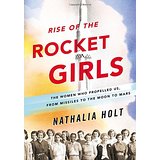Rising Women

Women who were good at math had few job opportunities in 1939, when this book begins. A few lucky ones became human computers with a start-up group of researchers who founded the Jet Propulsion Laboratory (JPL) at Cal Tech in Pasadena CA. Nathalia Holt interviewed many of these “rocket girls” and wrote their story. Long before digital computers, human “computers” used only paper, pencil and their minds to tackle complex mathematical equations. The rocket boys dreamed of exploring the solar system, dreams delayed by the US entry into WW II. The government needed them to design bombers and missiles. And they needed the rocket girls to do the computations. Here’s the interview that made me order the book immediately. It fits with two of my strong interests–outer space and women’s progress.
Women computers at JPL loved their work and soon became a tight sisterhood, helping each other solve problems and cross-checking results. They earned more than secretaries, but still at an hourly rate, unlike the salaried engineers whose work they made possible.
Women computers who got pregnant were expected to quit. As women’s liberation advanced in the 1960s and 70s with the Pill, pantyhose, and pant suits, they began to find day care for their children, get more cooperation from their husbands, and were welcomed back to JPL. Those of their husbands who transcended traditional roles generally stayed married; the ones who refused often got divorced. These females soon learned to program early computers more eagerly than the male engineers.
JPL became a part of the new National Aeronautics and Space Administration in 1958 and led in developing rocketry for the manned spacecraft program and outer space missions. I first became aware of JPL in 1966, when it ordered many books from the publishing company I worked for in Cambridge. As I read into the wee hours about the rocket girls’ valuable contributions to milestone events, I realized that they impacted three of my most vivid memories:
- being in high school band in May 1961 when Mr. Robbins, the Director, brought in a TV so that we could all watch the splash down and recovery of Alan Shepard as he completed the first manned Mercury flight
- being in the Rice stadium in September 1962 when President Kennedy announced the goal of landing on the Moon within the decade
- and staying up late at our Georgetown house on July 20, 1969 to watch Neal Armstrong land on the moon.
These women had helped make landing on the moon possible with their skillful hand-written computations. In 1970, the 50th anniversary of women’s suffrage, JPL computers officially became engineers, a breakthrough as big as landing on the moon, according to the author. When veteran boss Macie hired new women, she often told them, “In this job you need to look like a girl, act like a lady, think like a man, and work like a dog.”
Sometimes I got confused about who was who in the book; the author was on a first-name basis with the women she interviewed. Photos of the main characters at the beginning of each of the four sections helped. What I liked best was that the author organized a reunion of many of the original rocket girls in 2013 and included photos of them joyously together. I was reminded of my reunions with high school and college friends who are like the sisters I never had. I’m thrilled that Leslie, my hard-working daughter-in-law, is eager to read this book. She and my daughters are beneficiaries not only of the practical results of space exploration (Velcro etc), but also of the changes in lifestyle and attitudes that these women pioneered.
Rocket girls came from many backgrounds. Several were of Asian heritage and at least one at JPL-Cal Tech was black. They shared a passion for math. Sue Finley, though she never finished college, worked at JPL for 58 years, retiring in July 2016 at age 79, as soon as her long-time project Juno began sending back in-orbit pictures of Jupiter. Leslie and I are also excited about the new movie Hidden Figures, due in January 2017, which tells another true story about rocket women.
Leave a Reply